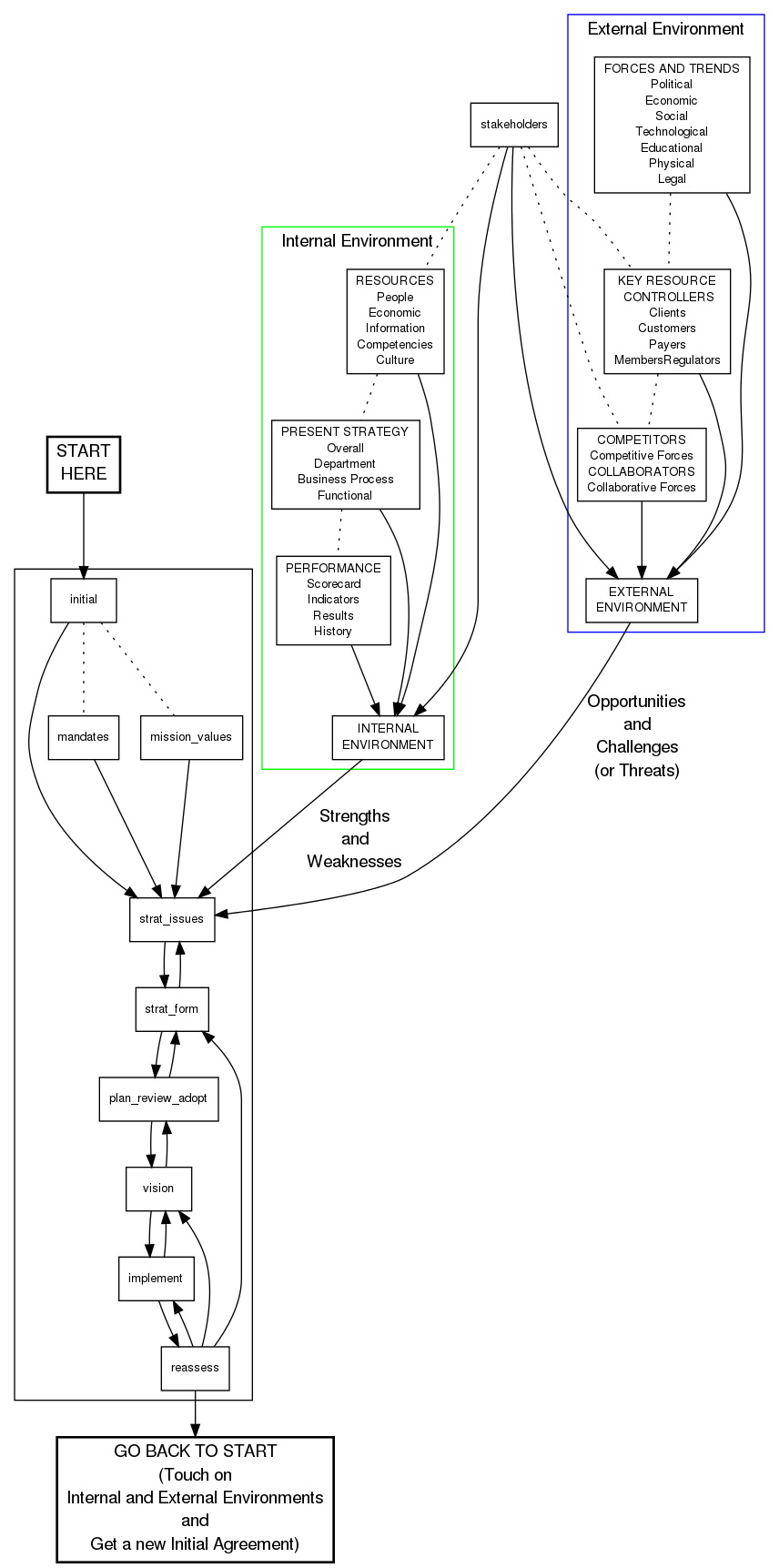Difference between revisions of "Strategic Planning Overview"
Jump to navigation
Jump to search
| (6 intermediate revisions by the same user not shown) | |||
| Line 1: | Line 1: | ||
| + | This is a rough overview of a strategic planning process. It is based on work by John M Bryson from the Humphrey Institute in Minneapolis. We will be tweaking and adjusting it to suit Free Geek's needs. | ||
| + | |||
<graphviz> | <graphviz> | ||
| Line 7: | Line 9: | ||
subgraph cluster_internal { | subgraph cluster_internal { | ||
| − | color= | + | color=red; |
label = "Internal Environment" [fontname="Helvetica"]; | label = "Internal Environment" [fontname="Helvetica"]; | ||
| Line 24: | Line 26: | ||
subgraph cluster_central { | subgraph cluster_central { | ||
| + | |||
| + | initial [label="INITIAL AGREEMENT\nReadiness assessment\nPlan for planning"] | ||
| + | mandates [label="MANDATES\nRequirements\nExpectations"] | ||
| + | mission_values [label="MISSION AND VALUES\nPurposes\nBy Stakeholders"] | ||
| + | strat_issues [label="STRATEGIC ISSUES\nDirect approach\nGoals approach\nVison of success approach\nIndrect approach\nOval mapping\nTensions approach\nSystem analysis"] | ||
| + | strat_form [label="STRATEGY FORMATION\nFive step process\nOval mapping\nDraft strategic plan"] | ||
| + | plan_review_adopt [label="STRATEGT\nPLAN REVIEW\nAND ADOPTION"] | ||
| + | vision [label="DESCRIPTION OF\nORGANIZATION IN THE FUTURE\n(Vision of\nsuccess option)"] | ||
| + | implement [label="IMPLEMENTATION"] | ||
| + | reassess [label="STRATEGY\nAND PLANNING\nPROCESS\nREASSESSMENT\nStrategy maintenance\n change, or termination\nStrategic management\n system design"] | ||
initial -> strat_issues | initial -> strat_issues | ||
| − | initial -> mandates [style="dotted | + | initial -> mandates [style="dotted"] |
| − | initial -> mission_values [style="dotted | + | initial -> mission_values [style="dotted"] |
mandates -> strat_issues | mandates -> strat_issues | ||
| Line 58: | Line 70: | ||
forces_trends [label="FORCES AND TRENDS\nPolitical\nEconomic\nSocial\nTechnological\nEducational\nPhysical\nLegal"] | forces_trends [label="FORCES AND TRENDS\nPolitical\nEconomic\nSocial\nTechnological\nEducational\nPhysical\nLegal"] | ||
| − | key_controllers [label="KEY RESOURCE\n CONTROLLERS\nClients\nCustomers\nPayers\nMembers\ | + | key_controllers [label="KEY RESOURCE\n CONTROLLERS\nClients\nCustomers\nPayers\nMembers\nRegulators"] |
comp_coll [label="COMPETITORS\nCompetitive Forces\nCOLLABORATORS\nCollaborative Forces"] | comp_coll [label="COMPETITORS\nCompetitive Forces\nCOLLABORATORS\nCollaborative Forces"] | ||
external_env [label="EXTERNAL\nENVIRONMENT"] | external_env [label="EXTERNAL\nENVIRONMENT"] | ||
| Line 69: | Line 81: | ||
} | } | ||
| − | start_here [label="START\nHERE", style="bold", fontsize="14"] | + | start_here [label="START\nHERE\n(Conceptually.\nYou actually often start\nin the middle somewhere.)", style="bold", fontsize="14"] |
end_here [label="GO BACK TO START\n(Touch on\nInternal and External Environments\nand\nGet a new Initial Agreement)", style="bold", fontsize="14"] | end_here [label="GO BACK TO START\n(Touch on\nInternal and External Environments\nand\nGet a new Initial Agreement)", style="bold", fontsize="14"] | ||
stakeholders [label="STAKEHOLDERS\n(People or groups\nthat can place a claim\non our attention,\nresources, or output,\nor are affected by\nour actions.)", style="bold"] | stakeholders [label="STAKEHOLDERS\n(People or groups\nthat can place a claim\non our attention,\nresources, or output,\nor are affected by\nour actions.)", style="bold"] | ||
| Line 81: | Line 93: | ||
external_env -> strat_issues [label="Opportunities\nand\nChallenges\n(or Threats)", color="blue"] | external_env -> strat_issues [label="Opportunities\nand\nChallenges\n(or Threats)", color="blue"] | ||
| − | internal_env -> strat_issues [label="Strengths\nand\nWeaknesses", color=" | + | internal_env -> strat_issues [label="Strengths\nand\nWeaknesses", color="red"] |
reassess -> end_here | reassess -> end_here | ||
} | } | ||
</graphviz> | </graphviz> | ||
| + | |||
| + | == Strategic Documents == | ||
| + | |||
| + | There are several documents that should be maintained during the course of strategic planning. We have some versions of some of these already available on this wiki. Here's a start to a more complete list: | ||
| + | |||
| + | * [[List of Mandates]] | ||
| + | ** (things we are required or heavily expected to do by outside forces and stakeholders) | ||
| + | * [[Mission Statement]] | ||
| + | * [[Programs and Activities|Program list]] (noting which programs are key to which stakeholders) | ||
| + | * Values statements ([[Free Geek Principles]]?) | ||
| + | * [[Free Geek Stakeholders]] (noting which are key stakeholders and why) | ||
| + | ** Internal | ||
| + | ** External | ||
| + | * SWOT (Strengths, Weaknesses, Opportunities, Threats) | ||
| + | ** External Forces and Trends | ||
| + | ** External Key Resource Controllers | ||
| + | ** External Competitors | ||
| + | ** External Collaborators | ||
| + | * Strategic issues (as opposed to operational issues) | ||
| + | * Vision of success (tied into strategic issues) | ||
| + | * Organizational chart with committees, departments, and job titles shown (possibly include key volunteers as well as staff) | ||
| + | |||
| + | |||
| + | [[Category: Strategic Planning]] | ||
Latest revision as of 13:53, 4 December 2010
This is a rough overview of a strategic planning process. It is based on work by John M Bryson from the Humphrey Institute in Minneapolis. We will be tweaking and adjusting it to suit Free Geek's needs.

Strategic Documents
There are several documents that should be maintained during the course of strategic planning. We have some versions of some of these already available on this wiki. Here's a start to a more complete list:
- List of Mandates
- (things we are required or heavily expected to do by outside forces and stakeholders)
- Mission Statement
- Program list (noting which programs are key to which stakeholders)
- Values statements (Free Geek Principles?)
- Free Geek Stakeholders (noting which are key stakeholders and why)
- Internal
- External
- SWOT (Strengths, Weaknesses, Opportunities, Threats)
- External Forces and Trends
- External Key Resource Controllers
- External Competitors
- External Collaborators
- Strategic issues (as opposed to operational issues)
- Vision of success (tied into strategic issues)
- Organizational chart with committees, departments, and job titles shown (possibly include key volunteers as well as staff)